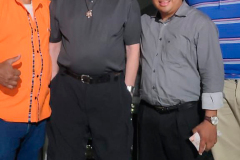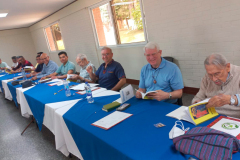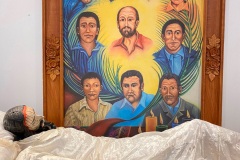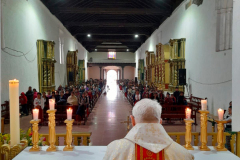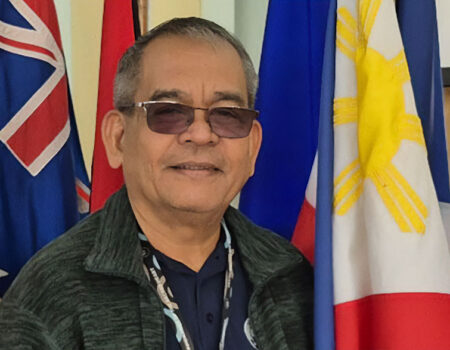Accompaniment: Central America /Mexico (CAM)
Saturday June 1, 2024
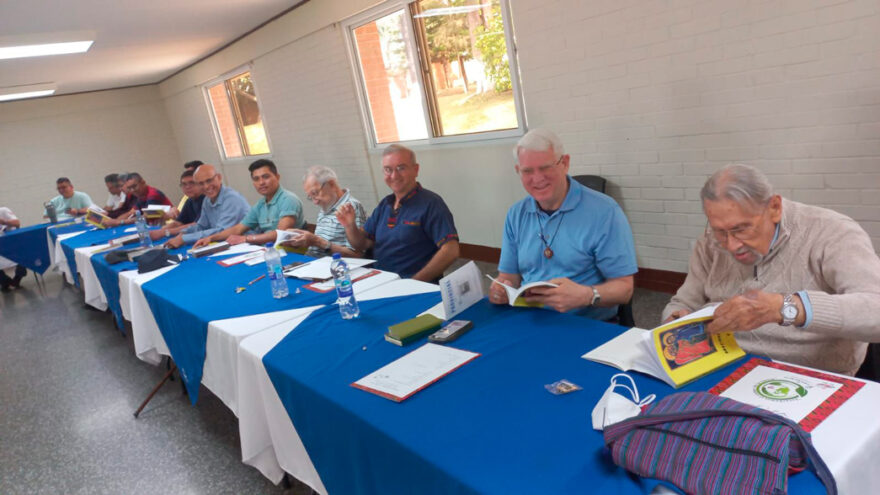
Michael Miller, MSC. I accompanied the Province of Central America/Mexico (CAM), representing the Superior General, to participate in the CAM retreat and Assembly on April 8-12.
On the weekend before the retreat, I travelled by car with Fr. Julio Molina, MSC and Leonardo Agostinho, MSC, to El Salvador to visit the MSC theologate members and the martyred Bishop Oscar Romero site. I was impressed to see how the chapel of the Sisters’ Hospital, where he was shot celebrating Mass, is a living shrine to Bishop Romero’s faith and a place of Catholic daily worship where the Eucharist is still celebrated. His small, humble apartment near the chapel has been made into a small museum of his life as a bishop, with the garments he wore when assassinated on display and other personal items. On Saturday morning during our visit, many boys and girls were making a pilgrimage with their catechists that day. It was a sign of keeping the memory alive of a modern martyr’s witness to the Catholic faith and his work for peace and justice for the dignity of all, especially the poor of El Salvador. We then drove to the University of Central America (UCA), where several Jesuit priests and laity were assassinated in their residence during the same time period. The site was closed, so we entered the nearby chapel and prayed at their burial places. It is a living sign of Jesus’ prediction to his disciples that persecution, rejection, and death would follow if one left all to follow him. It is a truth that continues today. Being a Christian and a faithful follower of Christ is a serious matter. But of course, our final destination is eternal life with our risen saviour, Jesus Christ.
Our last stop was the El Salvador Cathedral, where Bishop Romero is buried in the crypt. The cathedral is a holy living shrine to the Salvadorian people’s Christian faith.
Bishop Rafael Rodriguez from the Dominican Republic led the four-day retreat at the LaSalle Casa de Retiros. Each day, he offered us one reflection in the morning and one in the afternoon. The theme focused on living our MSC charism in unity and fraternity with the Sacred Heart and one another. A retreat offers the opportunity to do this by entering again into prayer with Jesus and listening to His heart calling to one’s own heart.
On Friday, the Assembly voted for provincial and councillors. Fr. Raúl Ruiz Mena was elected for a second term as Provincial, with Fr. Marvin Sotelo Lopez and Fr. Jairo Sevilla Mendoza as two councillors. I moderated the election.
After the Assembly, Fr. Julio Molina, Leonardo Agostinho, and I travelled by “Jimmy” to visit the mountainous sites of El Quiché, the MSC Guatemalan martyrs, pastoral places and formation houses. Our first stop was in Joyabaj, where Fr. Faustino Villanueva, MSC, along with a parishioner, were killed in the rectory by two assassins who fled on a motorcycle. While we waited for lunch with Fr. Santiago, the parish priest, we visited some beautiful new parish facilities constructed for catechesis. In the afternoon, we drove to the parish of El Espiritu Santo in Zacualpa, where the Franciscans (OFM) minister. It was there where the army set up their headquarters where they tortured and killed many innocent people accused of being communists just because they were Catholic. One of the youngest martyrs is Juan Barrera Mendez, who was just 12 years old.
We spent the night and the next day in Chajul where Fr. José Marie Gran, MSC and his sacristan were killed. We celebrated the 10 am Sunday Mass, and after lunch, the pastor drove us to the assassination site on the road just outside the parish. A small chapel has been built where Mass is celebrated to pray for the dead and keep their memory alive. Their mortal remains are buried in the parish church.
We then drove to the “Barranca”, where Fr. Juan Alonso, MSC, was captured, tortured and killed near Cunén. Parishioners who witnessed the tragedy showed us where his body was left in a steep embankment. Today, a concrete outdoor chapel has been constructed that incorporates the place of cruelty. We arrived in the evening at La Lancetillo, where Fr. Marvin hosted us at the parish where Fr. Juan’s mortal remains are buried in the parish church under the left front side altar. In the late afternoon, we drove several hours to spend the night in El Quiché, hosted by Bishop Juan Manuel.
We also visited Santiago de Atitlan, where Fr. Stanley Rother, a diocesan priest from Oklahoma, USA, was martyred. In the morning, we met Nate Bacon, a friend of Fr. Abzalόn, and enjoyed breakfast with him and two friends who knew Fr. Stanley. After breakfast, this friend accompanied us inside and outside the town, explaining many details of the conflicts and cruelties done by the authorities.
This experience gave me greater insight and appreciation of the faith of thousands of Catholics in Central America who lived their faith amidst the constant threat of persecution, torture and even death. As St. Tertullian said, “The blood of the martyrs is the seed of the Church.” May our faith be fortified as we ponder and meditate on the strength and courage of these men, women and children who remained faithful to Jesus Christ in their moments of trial. May we be faithful witnesses to Jesus Christ in the trials of our lives!


